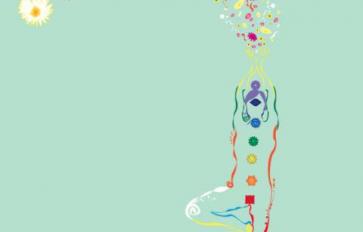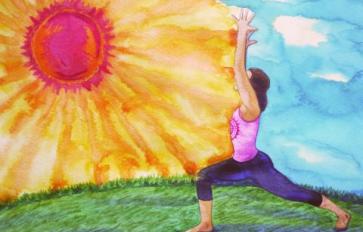
“At the center of non-violence stands the principle of love.” – Martin Luther King Jr.
On the surface it seems simple, yet the embodiment of this principle penetrates the deeper layers of our being. Ahimsa is the practice of non-violence. It is foundational to all yogic philosophy and within it we discover that love lies at the root.
We have come to understand that yoga is present in every living, breathing moment. It is a body of knowledge, a practice and a way of life. It dwells in many aspects of our daily existence, from how we see the world, the words we use, the ways we relate, the choices we make and ultimately how we move and act to shape our experience. Its presence is subtle and permeating. As we begin to understand the greater framework of yoga, we can look to the Yamas and Niyamas. These are moral codes of conduct, the restraints and observances that guide the pursuit of happiness, alleviate suffering and invite integrity in being.
Ahimsa is the first Yama, or observed restraint. The Sanskrit word can be broken down to “hiṃs” meaning to strike or “hiṃsā” indicating injury or harm. The preceding “a”-hiṃsā indicates the opposite. Thus, Ahimsa means non-harming. It is a familiar teaching and one that transcends religion and culture. From childhood, we are told to practice kindness, to share wealth, and to refrain from directing ill will towards others. We call it ‘easy to grasp’ when each morning our news is inundated with imagery of war and conflict. We see pain prevail and in that, we ‘understand’ the ways in which humans inflict harm upon each other. Yet even then, there is a sense of separation. Perhaps perpetuated by the screen, we often sit in the illusion that we practice ahimsa all the time. Here is where the beauty and power of yoga come into play. Yoga gives us the tools for self-inquiry and reflection. It empowers us to get real, to take a raw look at how we see ourselves and in turn the world around us. Our ability to practice ahimsa or nonviolence towards others is a direct reflection of our ability to be nonviolent towards ourselves. Practicing ahimsa is a physical, mental, and emotional endeavor.
Ahimsa is the guiding pillar for how we act, speak, and think. So much so that all the other Yamas and Niyamas rest upon its foundation. Our relationships mirror our internal landscape. Our internal landscape determines the way we carry ourselves in the world at large. As humans, our inherent nature is connected, and so our actions and engagements ripple out from within.
When we look at our actions outward, in the physical realm, we can recognize ahimsa as kindness toward all sentient creatures, including animals and plants. Rooted in the law of respect, we are encouraged to be mindful and compassionate. This translates to doing acts of kindness not only towards those we know and love, but to strangers we pass on the street. It asks us to question the consequences of our actions. How often are we unaware of how our behaviors affect those around us? Consider eating meat. Ahimsa begs the question, “Why kill to eat?” We must ask, is it in the animal’s dharma to serve as your nourishment? Was the cow treated with kindness, nurtured and nourished by love? Or was the cow, an animal deemed sacred in many parts of the world, mistreated and objectified. The energy carries over. This is not to say that eating meat is bad. There is a time and purpose for everything, and when done with sincere intention, we find ourselves living in alignment with heart. But it is important to ask ourselves the underlying reason for why we act out. Ahimsa challenges us to check in and see if our actions are truly coming from a place of love. Another example, medicine making: do we pillage the flowers in the meadows or do we ask first, take with intention, leave more than enough for the plant to sustain its lineage through the cycles of birth and death over and over again?
As we turn inward and dig deeper layers of consciousness, we unearth the necessity for courage in fulfilling ahimsa. Often times, negative or abusive actions come from a place of insecurity, hurt, or fear. Take anger. How often have you lashed out, spit fired words of malice as a reaction to something that pained you? Take dishonesty. Can you recall a time you withheld the truth – with someone you care about or even yourself – because let’s be honest, the truth can be terrifying. In the end, what was more harmful: the uncomfortable truth or the heavy lie? Anger and dishonesty are only two examples of inflicting violence, but what they have in common is their call to courage. Courage cannot exist without fear. Ahimsa and courage challenge us to rise above the internal chaos of our feelings and thoughts and move from a place of love. Author, scholar, and psychologist Brené Brown writes about this beautifully:
“Courage is a heart word. The root of the word courage is cor- the Latin word for heart. In one of its earliest forms, the word courage meant ‘to speak one’s mind by telling all one’s heart.’”
Practicing ahimsa brings our mind and heart into union. It comes from an inner wisdom that is often found in moments of strength and balance. When we are in a place of harmony, we are rooted in our self. Our heart and mind dwell in the same space, and we are living in a state of what yogis call “Svastha.” It is here in perfect health, strength and ease, that we are able to see the spectrum of our actions, widen our perceptions and understand both sides to the story. Through balance, we recognize how situations make us feel and in turn how they affect others. When we make choices that keep us in balance, that foster kindness and understanding, we then cultivate compassion.
While compassion relates to our widening circles of humanity, it begins with oneself. Compassion and ahimsa rests on the practice of self-love. This does not come easy to many of us. Self-love requires that we treat ourselves as we would a dear friend. So often we are our worst critics. We impose expectation upon our character, and judge ourselves when we fall short of our ideals. Often we are unaware of our internal dialogue – the words we use to strike ourselves down and the ways in which we tell ourselves we are not enough. It is when we begin to accept all parts of ourselves, even the parts that scare us, we are then able to extend this kindness out.
What we often forget, especially amidst the chaos of our own conflicts, is that everyone experiences suffering. It is universal. We experience a shared humanity. We have all felt loss, grief, heartbreak, anger, sadness, frustration, you name it. Mother Teresa said, “if we have no peace, it is because we have forgotten that we belong to each other.” Ahimsa reminds us of our shared humanity. It reminds us that loving-kindness extends beyond the boundaries of this one human being, and can be shared with all. A sweet reminder of this lies in The Book of Joy by the Dalai Lama and Archbishop Desmond Tutu. The Archbishop explains that in African Villages, when greeting one another the question is “How are we? This understands that someone else’s achievements or happiness is a very real way our own.”
And so we can remember that practicing ahimsa comes from a place of understanding that we are all connected. It reminds to be kind and loving, non-violent towards our inner and outer worlds, towards ourselves, and those around us. Ahimsa invites us to choose love in everyday life.








